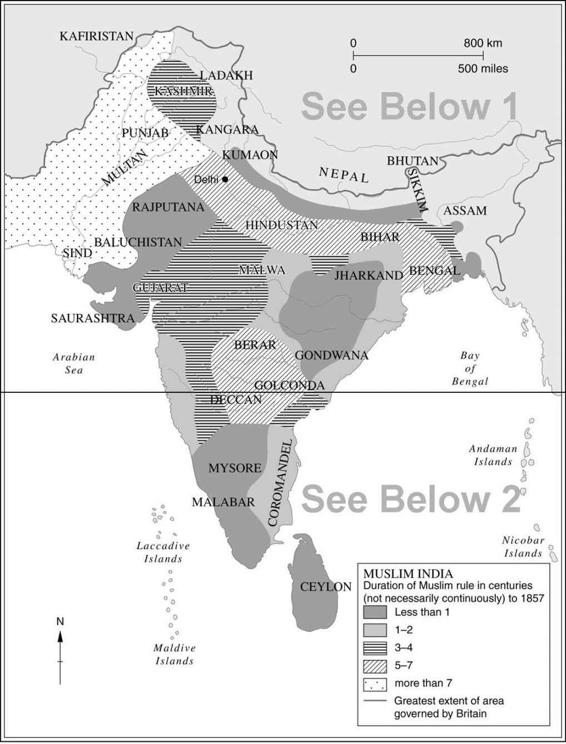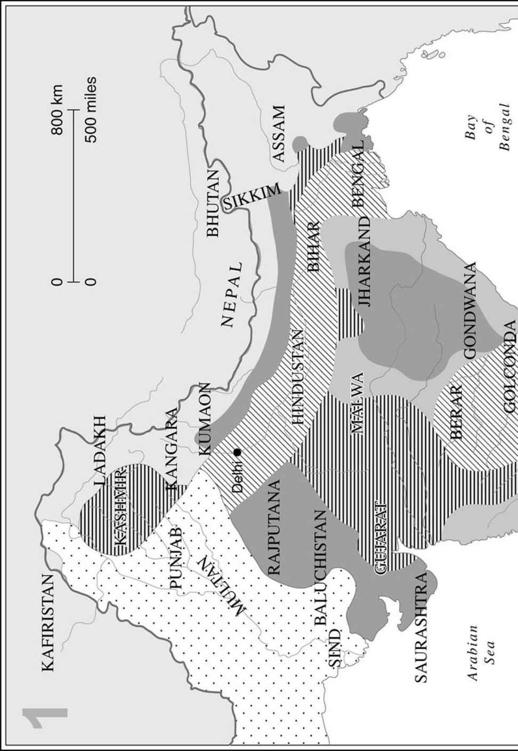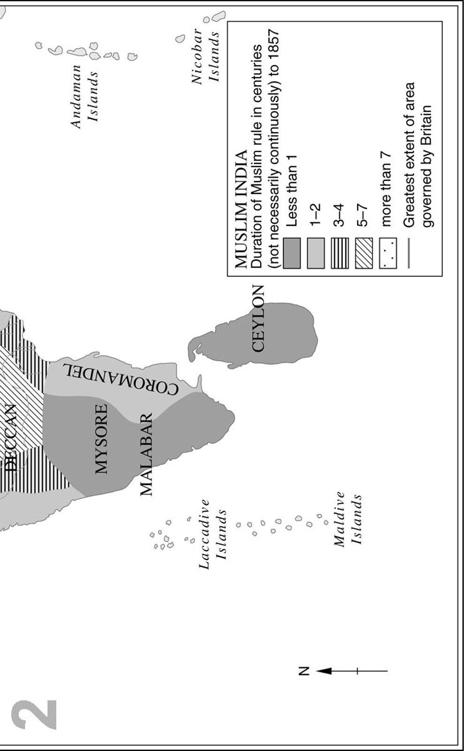The New Penguin History of the World (81 page)
Read The New Penguin History of the World Online
Authors: J. M. Roberts,Odd Arne Westad

He describes the India of a great ruler, Chandragupta, founder of the Maurya line. Something is known about him from other sources. The ancients believed that he had been inspired to conquest by having as a youth seen Alexander the Great during his invasion of India. However this may be, Chandragupta usurped the Magadha throne in 321
BC
and on the ruins of that kingdom built a state which encompassed not only the two great valleys of the Indus and Ganges, but most of Afghanistan (taken from the Seleucids) and Baluchistan. His capital was at Patna, where Chandragupta inhabited a magnificent palace. It was made of wood; archaeology still cannot help us much at this stage of Indian history. From Megasthenes’ account it might be inferred that Chandragupta exercised a sort of monarchical presidency but Indian sources seem to reveal a bureaucratic state, or at least something that aspired to be one. What it was like in practice is hard to see. It had been built from political units formed in earlier times, many of which had been republican or popular in organization, and many of these were connected to the emperor through great men who were his officers; some of these, nominally subjects, must often have been very independent in practice.
About the empire’s inhabitants, too, Megasthenes is informative. Besides providing a long list of different peoples, he distinguished two religious traditions (one the Brahmanical and the other apparently Buddhist), mentioned the rice-eating habits of Indians and their abstention from wine except for ritual purposes, said much about the domestication of elephants, and remarked on the fact (surprising to Greek eyes) that in India there were no slaves. He was wrong, but excusably so. Though Indians were not bought and sold in absolute servitude, there were those bound to labour for their masters and legally incapable of removal. Megasthenes also reported that the king diverted himself by hunting, which was done from raised platforms, or from the backs of elephants – much as tigers were shot in the twentieth century.
Chandragupta is said to have spent his last days in retirement with Jains, ritually starving himself to death in a retreat near Mysore. His son and successor turned the expansive course of empire already shown by his father to the south. Maurya power began to penetrate the dense rain-forests east of Patna, and to push down the eastern coast. Finally, under the third Maurya, the conquest of Orissa gave the empire control of the land and sea routes to the south and the subcontinent acquired a measure of political unity not matched in extent for over two thousand years. The conqueror
who achieved this was Asoka, the ruler under whom a documented history of India at last begins to be possible.



From Asoka’s era survive many inscriptions bearing decrees and injunctions to his subjects. The use of this means of propagating official messages and the individual style of the inscriptions both suggest Persian and Hellenistic influence, and India under the Mauryas was certainly more continually in touch with the civilizations to the West than ever before. At Kandahar, Asoka left inscriptions in both Greek and Aramaic.
Such evidence reveals a government capable of much more than that sketched by Megasthenes. A royal council ruled over a society based on caste. There was a royal army and a bureaucracy; as elsewhere, the coming of literacy was an epoch in government as well as in culture. There seems also to have been a large secret police, or internal intelligence service. Besides raising taxes and maintaining communication and irrigation services, this machine, under Asoka, undertook the promotion of an official ideology. Asoka had himself been converted to Buddhism early in his reign. Unlike Constantine’s conversion, his did not precede but followed a battle whose cost in suffering appalled Asoka. Be that as it may, the result of his conversion was the abandonment of the pattern of conquest which had marked his career until then. Perhaps this is why he felt no temptation to campaign outside the subcontinent – a limitation which, however, he shared with most Indian rulers, who never aspired to rule over barbarians and one which, of course, was only evident when he had completed the conquest of India.
The most remarkable consequence of Asoka’s Buddhism has usually been thought to be expressed in the recommendations he made to his subjects in the rock-inscriptions and pillars dating from this part of his reign (roughly after 260
BC
). They really amounted to a complete new social philosophy. Asoka’s precepts have the overall name of
Dhamma
, a variant of a Sanskrit word meaning ‘Universal Law’, and their novelty has led to much anachronistic admiration of Asoka’s modernity by Indian politicians of this century. Asoka’s ideas are, none the less, striking. He enjoined respect for the dignity of all men and, above all, religious toleration and non-violence. His precepts were general rather than precise and they were not laws. But their central themes are unmistakable and they were intended to provide principles of action. While Asoka’s own bent and thinking undoubtedly made such ideas agreeable to him, they suggest less a wish to advance the ideas of Buddhism (this is something Asoka did in other ways) than a wish to allay differences; they look very much like a device of government for a huge, heterogeneous and religiously divided
empire. Asoka was seeking to establish some focus for a measure of political and social unity spanning all India, which would be based on men’s interests as well as upon force and spying. ‘All men,’ said one of his inscriptions, ‘are my children.’
This may also explain his pride in what might be called his ‘social services’, which sometimes took forms appropriate to the climate: ‘on the roads I have had banyan trees planted,’ he proclaimed, ‘which will give shade to beasts and men’. The value of this apparently simple device would have been readily apparent to those who toiled and travelled in the great Indian plains. Almost incidentally, improvements also smoothed the path of trade, but like the wells he dug and the rest-houses he set up at nine-mile intervals, the banyan trees were an expression of
Dhamma
. Yet
Dhamma
does not appear to have succeeded, for we hear of sectarian struggles and the resentment of priests.
Asoka did better in promoting simple Buddhist evangelization. His reign brought the first great expansion of Buddhism, which had prospered, but had remained hitherto confined to north-eastern India. Now Asoka sent missionaries to Burma who did well; in Ceylon others did better still, and from his day the island was predominantly Buddhist. Those sent, more optimistically, to Macedonia and Egypt were less successful, though Buddhist teaching left its mark on some of the philosophies of the Hellenistic world and some Greeks were converted.
The vitality of Buddhism under Asoka may in part explain signs of reaction in the Brahmanical religion. It has been suggested that a new popularization of certain cults, which dates from about this time, may have been a conscious brahman response to challenge. Notably, the third and second centuries
BC
brought a new prominence to the cults of two of the most popular avatars of Vishnu. One is the proteiform Krishna, whose legend offers vast possibilities of psychological identification to the worshipper, and the other Rama, the embodiment of the benevolent king, good husband and son, a family god. It was in the second century
BC
, too, that the two great Indian epics, the
Mahabharata
and the
Ramayana
, began to take their final form. The first of these was extended by a long passage, which is now the most famous work of Indian literature and its greatest poem, the
Bhagavad Gita
, or ‘Song of the lord’. It was to become the central testament of Hinduism, weaving around the figure of Vishnu/Krishna the ethical doctrine of duty in the performance of the obligations laid upon one by membership of one’s class (
dharma
) and the recommendation that works of devotion, however meritorious, might be less efficacious than love of Krishna as a means to release into eternal happiness.
These were important facts for the future of Hinduism, but were to
develop fully only over a period which ran on far past the crumbling of the Mauryan empire, which began soon after Asoka’s death. Such a disappearance is so dramatically impressive – and the Mauryan empire had been so remarkable a thing – that, though we are tempted to look for some special explanation, yet perhaps there is only a cumulative one. In all ancient empires except perhaps the Chinese, the demands made on government eventually outgrew the technical resources available to meet them: when this happened, they broke up. The Mauryas had done great things. They conscripted labour to exploit large areas of wasteland, thereby both feeding a growing population and increasing the tax base of the empire. They undertook great irrigation works which survived them for centuries. Trade prospered under Maurya rule, if we may judge from the way northern pottery spread throughout India in the third century
BC
. They kept up a huge army and a diplomacy which ranged as far afield as Epirus. The cost, however, was great. The government and army were parasitical upon an agricultural economy which could not be indefinitely expanded. There was a limit to what it could pay for. Nor, though bureaucracy seems at this distance to have been centralized in principle, was it likely to have been very effective, let alone flawless. Without a system of control and recruitment to render it independent of society, it fell at one end into the hands of the favourites of the monarch on whom all else depended and at the other into the gift of local élites who knew how to seize and retain power.
One political weakness was rooted deep in pre-Maurya times. Indian society had already sunk its anchors in the family and the institutions of caste. Here, in social institutions rather than in a dynasty or an abstract notion of a continuing state (let alone a nation), was the focus of Indian loyalties. When an Indian empire began to crumble under economic, external or technical pressures, it had no unthinking popular support to fall back upon. This is a striking indication of the lack of success of Asoka’s attempts to provide ideological integument for his empire. What is more, India’s social institutions, and especially caste, in its elaborated forms, imposed economic costs. Where functions were inalterably allocated by birth, economic aptitude was held back. So was ambition. India had a social system which was bound to cramp the possibilities of economic growth.
The assassination of the last Maurya was followed by a Ganges dynasty of Brahmanical origin and thereafter the story of India for five hundred years is once more one of political disunity. References in Chinese sources become available from the end of the second century
BC
, but it cannot be said that they have made agreement between scholars about what was
happening in India any easier; even the chronology is still largely conjectural. Only the general processes stand out.
The most important of these is a new succession of invasions of India from the historic north-western routes. First came Bactrians, descendants of the Greeks left behind by Alexander’s empire on the upper Oxus, where by 239
BC
they had formed an independent kingdom standing between India and Seleucid Persia. Our knowledge of this mysterious realm is largely drawn from its coins and has grave gaps in it, but it is known that a hundred years later the Bactrians were pushing into the Indus valley. They were the foremost in a current which was to flow for four centuries. A complex series of movements was in train whose origins lay deep in the nomadic societies of Asia. Among those who followed the Indo-Greeks of Bactria and established themselves at different times in the Punjab were Parthians and Scythians. One Scythian king, according to legend, received St Thomas the apostle at his court.
